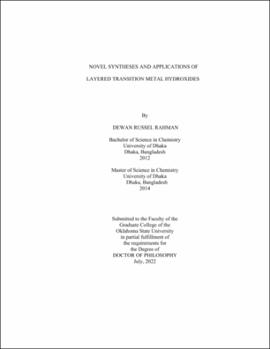| dc.contributor.advisor | Apblett, Allen | |
| dc.contributor.author | Russel Rahman, Dewan | |
| dc.date.accessioned | 2023-04-05T16:21:17Z | |
| dc.date.available | 2023-04-05T16:21:17Z | |
| dc.date.issued | 2022-07 | |
| dc.identifier.uri | https://hdl.handle.net/11244/337320 | |
| dc.description.abstract | The dissertation herein reports the serendipitous discovery of hydrolysis reactions of later 3d transition metal acetates that deposit nanostructured thin films of corresponding layered metal hydroxides, M(OAc)2-x(OH)x·nH2O or metal hydroxides, M(OH)2 (where M is Cu, Ni, Co, and Zn; and OAc is acetate, CH3COO-). At 90°C, aqueous copper acetate solutions deposited acetate-intercalated layered copper hydroxide that in 24 hours transformed into CuO films decorated with aggregated spherical particles. Using this reaction, it was possible to produce stoichiometric CuO on silica pellets and mesoporous silica after thermolysis of the deposited copper acetate hydroxide. While nickel acetate hydrolysis produced films consisting of web-like nanowalls of nickel acetate hydroxide. These could subsequently be converted by heating into NiO films while maintaining the same morphology. Interestingly, hydrolysis of cobalt and zinc acetates produced thin films of β-Co(OH)2 and ZnO/Zn(OH)2, respectively, that can easily be transformed into Co3O4 or CoOOH and ZnO films by pyrolysis. ZnO/Zn(OH)2 was deposited as nanosphere-type particles almost uniformly distributed across the substrates, while β-Co(OH)2 was grown as a dual nanomorphology – interconnected nanowalls forming a network-like structure and nanosphere-type particles. A solution growth process for deposition β-Ni(OH)2 and α-N(OH)2 using aqueous hexamine nickel(II) hydroxide, Ni(NH3)6(OH)2 solutions were also investigated. Evaporation of ammonia from the solutions of Ni(NH3)6(OH)2 deposited highly crystalline β-Ni(OH)2 films. While the addition of sodium aluminate to the nickel-ammonia complex facilitated the growth of aluminum-substituted α-Ni(OH)2 membranes with the formula Ni0.74Al0.26(OH)2.26·1.5H2O at the solution/air interface. | |
| dc.description.abstract | Additionally, propylene oxide assisted-hydrolysis reactions of later 3d transition metals acetates were investigated to produce acetate-intercalated layered hydroxides (metal acetate hydroxides) in high yields. Hydrolysis of copper acetate aqueous solution with excess propylene oxide at 40°C produced crystalline copper acetate hydroxide, Cu(OAc)0.44(OH)1.56·0.50H2O with a yield of 100%. Zinc acetate aqueous solution generated zinc acetate hydroxide, Zn(OAc)0.33(OH)1.67·0.50H2O with a yield of 93.6%. However, nickel or cobalt acetate did not produce layered hydroxides; instead, they formed β-Ni(OH)2 or β-Co(OH)2. The uptake of phosphate and arsenate using layered zinc acetate hydroxide synthesized via the propylene oxide-assisted hydrolysis method was investigated. Zinc acetate hydroxide has an initial rapid uptake of phosphate from hydrogen phosphate solutions, corresponding to ion exchange of phosphate for acetate. Beyond this point, a slow acid-base reaction continued by which hydroxides were neutralized by hydrogen phosphate. This led to high phosphate uptake capacity of 259 mg/g after 7 days at room temperature and 356 mg/g after 7 days at 45 °C. Unlike phosphate, arsenate uptake was low 60 mg/g and appeared to be limited to surface adsorption. | |
| dc.format | application/pdf | |
| dc.language | en_US | |
| dc.rights | Copyright is held by the author who has granted the Oklahoma State University Library the non-exclusive right to share this material in its institutional repository. Contact Digital Library Services at lib-dls@okstate.edu or 405-744-9161 for the permission policy on the use, reproduction or distribution of this material. | |
| dc.title | Novel syntheses and applications of layered transition metal hydroxides | |
| dc.contributor.committeeMember | Lavine, Barry | |
| dc.contributor.committeeMember | Cook, Gabriel | |
| dc.contributor.committeeMember | Vasquez, Yolanda | |
| dc.contributor.committeeMember | Singh, Raman Pal | |
| osu.filename | russelrahman_okstate_0664d_17808.pdf | |
| osu.accesstype | Open Access | |
| dc.type.genre | Dissertation | |
| dc.type.material | Text | |
| thesis.degree.discipline | Chemistry | |
| thesis.degree.grantor | Oklahoma State University | |
